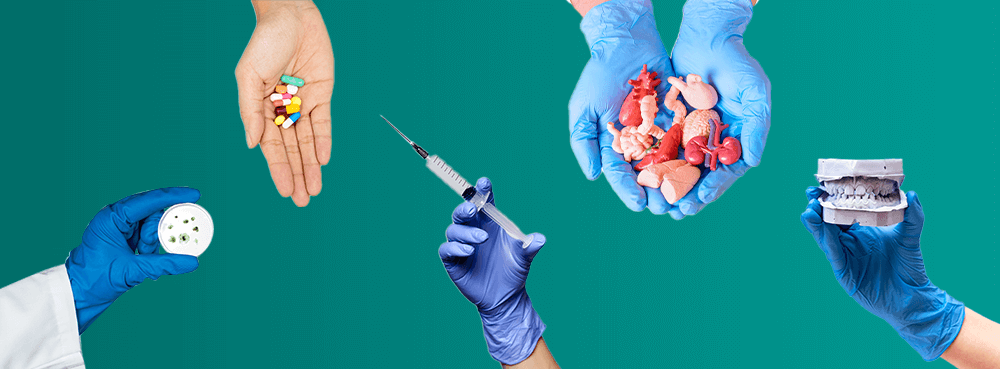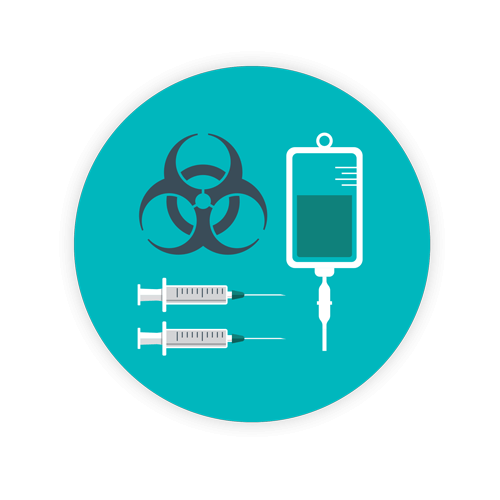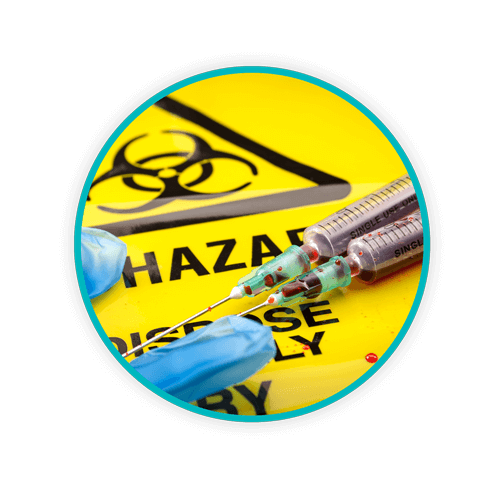What is Clinical Waste?

Editor’s note: This post was originally published in September 2019 and has been completely revamped and updated for accuracy and comprehensiveness.
What is clinical waste? Have you ever asked that question? How would you answer it if someone asked you?
Whatever your role within healthcare involves, at some point in your working day you’ll most likely come into contact with clinical waste – you need to be able to identify it.
Understanding clinical waste will give you a solid foundation for making healthcare safer with waste management practices that reduce the risks of contamination and infection transmission, protecting staff, patients, and the environment.
TOPICS WE WILL COVER:
2 / 10 Clinical Waste Examples
3 / Is All Clinical Waste Hazardous?
4 / How to Identify Clinical Waste
5 / What Colour are Clinical Waste Bins?
6 / Avoid the Fines and Penalties for Non-Compliance
7 / Looking for Clinical Waste Guidance?
What Is Clinical Waste?
Clinical waste refers to a specific category of waste produced in healthcare settings such as hospitals, health clinics, dental practices, and research labs.
This type of waste poses a risk of infection, disease, or harm to anyone who comes into contact with it.
It’s important to note that not all waste from healthcare environments falls under the category of clinical waste, but it’s all considered as healthcare waste.
Please refer to the Health Technical Memorandum (HTM) 07-01 for more information on the safe and sustainable management of healthcare waste.
10 Clinical Waste Examples
Every healthcare worker comes into contact with waste at some point in the working day and it’s critical to be able to identify whether it’s clinical or non-clinical, from both a safety standpoint and a sustainability one.
Examples of clinical waste include:
Sharps Waste
Sharps waste includes any item that has the potential to cut, pierce, or puncture skin including syringes, needles, scalpels, and other items defined as ‘sharps’.
Anatomical Waste
Anatomical waste includes limbs, blood bags, and waste material from biopsy procedures where tissues or tissue samples may be taken.
Pharmaceutical Waste
Pharmaceutical waste includes any unused or expired pharmaceutical products and/or drugs that aren’t cytotoxic or cytostatic.
Liquid Medicine Waste
Liquid medicine waste includes two main types: medicine delivered via a sharp and unused or expired liquid medicinal products.
Infectious Waste
Infectious waste falls into one of two categories:
Infectious waste for alternative treatment – waste such as PPE, dressings, and IV tubings that have come into contact with infectious bodily fluids and isn’t medicinally or chemically contaminated.
This also includes waste generated by a patient diagnosed with any communicable disease.
Infectious waste for incineration – waste classified as being highly infectious due to secondary contamination such as medicinal or chemical.
(Infectious) Gypsum or Dental Amalgam
Gypsum and waste containing dental amalgam are considered as clinical waste only if deemed to be infectious.
Cytotoxic or Cytostatic Waste
Cytotoxic or cytostatic waste includes any medicinal product containing hazardous properties such as being toxic, carcinogenic, toxic for reproduction, or mutagenic.
Not limited to medicinal products alone, this also includes waste generated from the care of a patient prescribed a cytotoxic or cytostatic drug.
Contaminated PPE
Any personal protective equipment or other materials that have been contaminated by coming into contact with, saturated, or soaked with blood, bodily fluids, or other materials deemed as infectious.
Microbial Waste
Microbial waste can include cultures, slides, specimens, or other microorganisms. Even empty vaccine vials might contain contents that may prove dangerous, especially if expired or contaminated with bacteria.
Contaminated Lab Equipment
Contaminated laboratory equipment can include lab tools, items, or other equipment such as cultures, Petri dishes, glass slides, etc.
How does an easy-to-scan reference of these clinical waste examples sound?
Download our free 10 Examples of Clinical Waste poster!
Is All Clinical Waste Hazardous?
Whilst not all clinical waste is hazardous, such as medicines other than those that are cytotoxic or cytostatic; hazardous clinical waste is broken into three classifications or categories of material:
- Any healthcare waste that poses a risk of infection.
- Certain healthcare wastes that may trigger a chemical hazard.
- Medicines and medicinally-contaminated waste that contains a hazardous pharmaceutically active agent.
The HTM 07-01 clearly states that: “The only healthcare wastes that can be both clinical and non-hazardous waste are non-cytotoxic and non-cytostatic medicines.”
It’s also worth noting that hazardous clinical waste has the potential to be both infectious and chemically contaminated, such as the type found in a diagnostic kit, and as such, requires packaging in a yellow UN-certified sack or rigid container.
So whilst clinical waste is a waste classification of its own, it also falls under the classification as hazardous waste.
How to Identify Clinical Waste
Every employee or worker of a facility, hospital, or medical centre that produces clinical waste must be able to identify it and maintain proper processes and procedures to ensure it’s contained, isolated, and properly disposed of.
Compliant use of containers or bins and storage of such waste is the foundation of safe healthcare waste management and includes every employee from management, on-floor staff, and domestic and portering teams.
Clinical waste can be divided into three broad groups of materials:
- Any healthcare waste which poses a risk of infection.
- Certain healthcare wastes which pose a hazard.
- Medicines and medicinally-contaminated waste containing a pharmaceutically active ingredient.
Clinical waste can be deadly, and all the more so if it’s mismanaged or misidentified.
Proper handling of clinical waste reduces the risks of contamination and infection transmission, ensuring the protection of healthcare workers, patients, the public, and the environment.
Need help identifying your clinical waste?
What Colour Are Clinical Waste Bins?
Understanding the colour coding guidance published in the Health Technical Memorandum (HTM) 07-01 will help you ensure correct segregation and safer, compliant clinical waste management.
The main clinical waste bin colours are:
- Yellow Bag: Infectious waste contaminated with medicines or chemicals.
- Orange Bag: Infectious waste that doesn’t have any other hazardous properties.
- Yellow Lid Sharps Container: Sharps waste contaminated with medicines or chemicals other than cytotoxic/cytostatic components.
- Orange Lid Sharps Container: Non-medicinally contaminated sharps waste.
- Purple (Bag or Sharps Container): Cytotoxic and/or cytostatic waste.
- Blue (Bag or Container): Non-hazardous pharmaceutical waste.
- Red or Red Lid Container: Anatomical waste.
Click here to read our blog on the different types of bins you’ll find in a hospital (it’s more interesting than it sounds, we promise…)
Avoid the Fines and Penalties for Non-Compliance
Unfortunately, the majority of common healthcare waste violations and offences occur as a result of staff not being properly trained in healthcare waste management.
Some common areas for improvement are:
- Understanding how to correctly segregate waste at point of care, particularly the difference between orange (infectious) and tiger stripe (offensive) sacks.
- The colour coding outlined in HTM 07-01 and keeping them segregated in wheeled containers.
- Segregating cytotoxic and cytostatic wastes from other streams.
- Healthcare waste paperwork, how to check and complete it, and how long to store it.
Knowing the regulations to maintain compliance when managing your healthcare waste is crucial for avoiding fines, penalties and sanctions.
Looking for Clinical Waste Guidance?
Whether you’re looking for some guidance and advice or a reliable clinical waste disposal service that puts you first, we’re here to help.
At Sharpsmart, our mission has always been to make healthcare safer and we’re dedicated to protecting healthcare workers and the environment. Our clinical waste experts work with your teams within the four walls of your organisation, empowering your staff to manage your waste in the most effective way possible.
If you’d like to discover how we can help improve your clinical waste management, please don’t hesitate to get in touch.
Let's Talk!
Your time is valuable, and we don’t want to play hard to get. You can either phone us directly on the details listed on our contact page, or feel free to fill out this short form and one of our team members will get back to you as quickly as possible.

